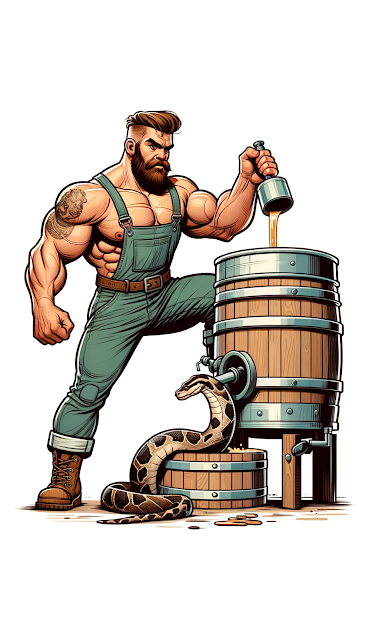These extracts, derived from malted barley, are crucial tools in the brewer’s toolkit, allowing for greater control and flexibility in the brewing process.
Understanding the differences between DME and LME is more than just a technical detail; it’s a gateway to mastering the nuances of brewing.
Whether you're a novice just starting to experiment with homebrewing or a seasoned brewer perfecting your next recipe, the choice between DME and LME can significantly impact the beer’s final outcome.
From the subtle variations in flavor and color to the precise control over the beer’s gravity, each form of malt extract offers unique advantages and challenges. By delving into the specifics of these extracts, brewers can elevate their craft, creating beers that not only satisfy the palate but also reflect a deep understanding of the brewing process.
What is the Difference Between Dry Malt Extract (DME) and Liquid Malt Extract (LME)?
Composition and Form:
- Dry Malt Extract (DME): DME is malted barley that has been processed to remove most of the water content, resulting in a fine, dry powder. Its low moisture content makes it less prone to spoilage.
- Liquid Malt Extract (LME): LME, on the other hand, is a thick syrup with a higher water content. It is essentially the same product as DME before the final drying stage.
Sugar Content and Efficiency:
- Since DME has less water, it has a higher concentration of sugars. This means that DME will contribute more to the beer's specific gravity per unit of weight compared to LME, which has a portion of its weight attributed to water.
Usage and Conversion:
- In brewing recipes, DME and LME are not interchangeable on a one-to-one basis due to their difference in water content. A general conversion is that 1 pound of DME is roughly equivalent to 1.25 pounds of LME.
Is Barley Malt Syrup the Same as Liquid Malt Extract?
Barley Malt Syrup vs. Liquid Malt Extract (LME):
While barley malt syrup and liquid malt extract (LME) share some similarities, they are distinct products with different characteristics and uses in both brewing and culinary applications.
Composition and Production:
Barley Malt Syrup: This syrup is made by mashing malted barley, extracting the sugars, and then concentrating them into a thick, viscous syrup. Barley malt syrup is generally less refined than LME. This means it may contain a broader range of carbohydrates, including complex sugars and starches, in addition to the simple fermentable sugars typically found in LME. The less refined nature of barley malt syrup often results in a product with a richer, more robust malt flavor, but with a lower percentage of fermentable sugars.
Liquid Malt Extract (LME): LME is produced through a similar process of mashing and extracting sugars from malted barley. However, LME undergoes additional refining processes to concentrate the fermentable sugars. This results in a product that is specifically designed for brewing, with a higher percentage of simple sugars like maltose that yeast can readily ferment. LME is available in various color grades, from light (pale) to dark, each suited for different styles of beer.
Uses in Brewing:
Barley Malt Syrup: Due to its lower fermentability and less refined nature, barley malt syrup is generally not the preferred choice for brewing. Its complex sugars and starches might not fully ferment, leading to a sweeter, heavier beer with potential off-flavors. While it could be used in brewing in a pinch, it would require careful consideration and adjustments to the recipe, particularly in terms of yeast selection and fermentation management.
Liquid Malt Extract (LME): LME is specifically tailored for brewing, offering a reliable source of fermentable sugars that contribute to the beer's alcohol content, body, and flavor. It’s a staple in extract brewing, allowing brewers to achieve consistent results. LME can be used as the primary source of fermentable sugars or as a supplement in all-grain brewing to adjust gravity or add specific malt characteristics.
What is the Purpose of Dried Malt Extract?
In Brewing: Dried Malt Extract (DME) is a versatile and essential ingredient in brewing, primarily used to introduce fermentable sugars into the wort. Its concentrated nature makes it ideal for increasing the alcohol content and enhancing the body of the beer without adding excessive volume. This is particularly advantageous in brewing processes where maintaining a specific liquid volume is crucial, such as in small-batch brewing or when targeting a specific beer style.
Precision in Beer Styles: DME is particularly useful for achieving precision in beer styles that demand exacting control over flavor and gravity. For example, in brewing light lagers or pilsners, where the balance of malt sweetness and alcohol content is delicate, DME allows brewers to fine-tune the final product. By adjusting the amount of DME, brewers can control the specific gravity, influencing the mouthfeel, body, and overall flavor profile, ensuring the beer meets the desired specifications.
In All-Grain Brewing: Even in all-grain brewing, where the primary sugars are derived from malted grains, DME serves as a valuable supplemental ingredient. It can be used to correct or adjust the wort’s gravity if it falls short of the target, ensuring the beer's final alcohol content and flavor are on point. Additionally, DME can enhance the malt character of the beer, providing an extra layer of complexity to the malt profile. This is especially useful in brewing stronger beer styles, like imperial stouts or barleywines, where a rich, malty backbone is desired.



